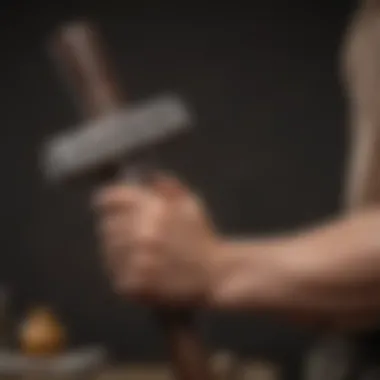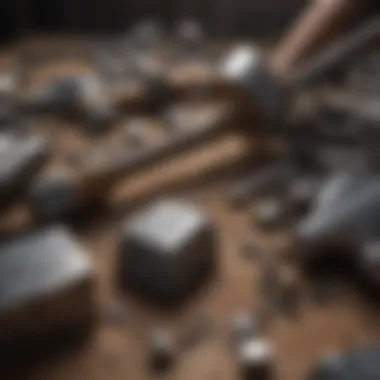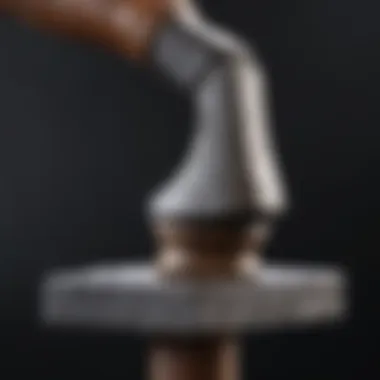Unveiling the Ultimate Hammer Selection Guide for Metal Working Mastery


Metal work requires precision and efficiency, making the selection of the right hammer crucial for enthusiasts and professionals alike. This comprehensive guide delves into the realm of choosing the optimal hammer for metal work, exploring various considerations from material to handle design. By understanding these aspects, individuals can make well-informed decisions to enhance their metalworking endeavors.
Types of Hammers for Metal Work
When it comes to metal work, not all hammers are created equal. Different types of hammers serve specific purposes, such as ball-peen hammers for shaping and straight-peen hammers for striking. Understanding the functions of each type will help you determine the most suitable hammer for your metalworking needs.
Considerations for Material Selection
The material of a hammer greatly affects its performance. For metal work, hammers made of high-quality steel are preferred due to their durability and impact resistance. Consider the hardness of the material you are working with to ensure compatibility with the hammer material, promoting efficient and effective results.
Ergonomic Handle Design
The design of the handle plays a crucial role in the overall usability and comfort of a hammer. Ergonomically designed handles reduce strain on the wrist and arm, enabling users to work for extended periods without fatigue. Additionally, a non-slip grip enhances control and accuracy, contributing to precise metalwork outcomes.
Weight and Balance
The weight and balance of a hammer are essential factors to consider for effective metal work. While lighter hammers offer increased control for delicate tasks, heavier hammers provide greater impact force for shaping and forming metals. Finding the right balance between weight and maneuverability is key to achieving optimal results in metalwork projects.
Synthesizing the Information
By exploring the various aspects of selecting the best hammer for metal work, individuals can make informed decisions that align with their specific needs and preferences. Whether prioritizing durability, ergonomics, or functionality, understanding the factors that contribute to a quality hammer will enhance the overall metalworking experience.
Introduction
In the intricate world of metalwork, the choice of hammer holds significant importance, serving as a fundamental tool that can elevate or hinder the quality of the final product. This article embarks on a thorough exploration of selecting the most suitable hammer for metalwork tasks, catering to both enthusiastic hobbyists and seasoned professionals alike. By delving into the nuances of hammer selection, we aim to provide invaluable insights that empower individuals to achieve precision and efficiency in their craft.
The essence of this article lies in unraveling the various elements that underline the significance of choosing the right hammer for metalwork purposes. From the very onset, it becomes evident that the type of hammer wielded can profoundly impact the outcome of the work, influencing factors such as precision and efficiency. Furthermore, the selection process involves meticulous considerations that extend beyond mere aesthetics, delving into the realm of material composition, weight distribution, handle design, and specialized functionalities. By understanding the critical role of the hammer in metalwork, individuals can maximize their productivity and craftsmanship, ensuring that each strike yields optimal results.
By immersing ourselves in the realm of hammer selection, we set the stage for an in-depth exploration that uncovers the intricacies of this seemingly simple yet indispensable tool. Through a comprehensive analysis of key considerations and factors, this article equips readers with the knowledge needed to make well-informed decisions when choosing a hammer for metal work. The journey ahead involves a meticulous examination of material composition, handle ergonomics, and specialized hammer types, each playing a crucial role in determining the suitability of the tool for specific metalwork tasks. As we navigate through the nuances of hammer selection, we aim to empower our audience with the expertise needed to elevate their craft and achieve excellence in the realm of metalworking.


Understanding the Importance of a Quality Hammer
In the realm of metal work, the significance of utilizing a quality hammer cannot be overstated. This article aims to delve deep into the pivotal role that a high-quality hammer plays in ensuring precision, efficiency, and overall work quality. As enthusiasts and professionals alike seek tools that can elevate their craftsmanship, understanding the importance of selecting the right hammer becomes paramount. By focusing on specific elements such as material composition, weight distribution, and handle design, individuals can make informed decisions that directly impact their work outcomes.
Impact of Hammer on Work Quality
Precision
Precision in a hammer is not merely a desirable feature but a non-negotiable factor when it comes to achieving meticulous metal work. The ability of a hammer to deliver precise strikes with exact force and accuracy significantly enhances the final results of any project. The key characteristic of precision lies in its capability to target specific areas with controlled strength, allowing for fine adjustments and detailed work. Opting for a hammer renowned for its precision ensures that every strike serves its intended purpose, resulting in immaculate finishes and refined craftsmanship.
Efficiency
Efficiency stands as another crucial aspect influenced by the choice of hammer in metal work settings. An efficient hammer maximizes the user's energy output, translating into swift and effective work processes. The hallmark of efficiency in a hammer is its ability to transfer the applied force directly and effectively to the workpiece, minimizing wasted energy and optimizing productivity. By selecting a hammer known for its efficiency, individuals can execute tasks with ease and speed, streamlining their workflow and enhancing overall project turnover.
Durability for Long-Term Use
In addition to precision and efficiency, durability emerges as a fundamental consideration for individuals engaging in metal work over extended periods. A hammer's longevity and resilience are pivotal in ensuring that it withstands the rigors of frequent use without compromising its performance. By opting for durable hammers crafted from robust materials and featuring reinforced components, users equip themselves with tools that can endure heavy-duty tasks without succumbing to wear and tear. Investing in hammers renowned for their long-term durability not only guarantees consistent performance but also minimizes the need for frequent replacements, ultimately proving cost-effective in the long run.
Key Factors to Consider
Material Composition
Steel Hammers
Steel hammers are renowned for their strength and durability, making them a popular choice for various metalworking tasks. The key characteristic of steel hammers lies in their robust construction, capable of withstanding heavy-duty use without compromising performance. Their unique feature includes high impact resistance, ensuring longevity and reliability in demanding work environments.
Titanium Hammers
Titanium hammers offer a lightweight yet sturdy alternative to traditional steel hammers. Their key characteristic is the exceptional strength-to-weight ratio, providing adequate power for metal work while reducing user fatigue. Titanium hammers' unique feature is their corrosion resistance, making them ideal for outdoor or marine applications. However, their main disadvantage is the higher cost compared to steel hammers.


Alloy Hammers
Alloy hammers combine different metals to achieve specialized properties tailored to specific metalworking tasks. The key characteristic of alloy hammers is their versatility, as they can be customized for hardness, flexibility, and impact strength. The unique feature of alloy hammers is their adaptability to different working conditions, enhancing precision and efficiency. However, selecting the right alloy composition is crucial to optimize performance and durability.
Weight Distribution for Control
Handle Design and Grip
Ergonomic Handles
Anti-Vibration Features
Non-Slip Grip
Types of Hammers for Metal Work
The section focusing on Types of Hammers for Metal Work in this guide is crucial as it sheds light on the diverse options available to metalworkers. Understanding the specific types of hammers is essential for selecting the right tool for the job at hand. Each type offers unique benefits and considerations that cater to different aspects of metalworking, ensuring precision and efficiency in every task.
Ball Peen Hammer
The Ball Peen Hammer is a versatile tool known for its spherical peen, which is ideal for striking and shaping metal. This hammer is widely utilized in metalworking for riveting, bending, and shaping metal surfaces. Its round peen allows for controlled blows that can flatten or shape metal without causing damage. The flat face of the hammer is perfect for creating texture, planishing, and finishing touches on metal surfaces. When choosing a Ball Peen Hammer, considering the weight of the head and handle material is essential to ensure comfort and accuracy in metalwork tasks.
Cross Peen Hammer
The Cross Peen Hammer is distinguished by its wedge-shaped peen, making it a valuable tool for metalworking tasks that require precision and control. This hammer is commonly used for riveting and shaping metal by concentrating force in a specific direction, allowing for accurate and defined blows. The cross peen end enables metalworkers to create intricate designs, textures, and manipulate metal with finesse. Selecting a Cross Peen Hammer with an ergonomically designed handle ensures a secure grip and reduces hand fatigue during prolonged use.
Club Hammer
The Club Hammer, also known as a lump hammer, is a robust tool favored for heavy-duty metalworking applications that require forceful impact. This hammer features a double-faced head, with one side flat and the other typically rounded. The Club Hammer is commonly used for demolition, chiseling, and driving large fasteners into metal surfaces. Its compact size and substantial weight make it suitable for tasks that demand power and strength. When choosing a Club Hammer, considering the material of the head and handle durability is vital to withstand rigorous use without compromising performance.


Selecting the Ideal Hammer for Specific Metal Works
In the realm of metal work, selecting the ideal hammer for specific tasks is crucial, as it directly impacts the quality and efficiency of the work undertaken. Different metal work techniques require specific hammers tailored to their needs, emphasizing the importance of choosing the right tool for the job. Precision, control, and impact are key elements to consider when selecting a hammer for specific metal works, ensuring that each strike yields the desired result with accuracy and finesse.
Precision Welding
Precision welding demands a hammer that allows the welder to delicately adjust and align metal pieces with accuracy. A hammer with a fine, smooth face surface is essential to prevent damage to the delicate weld joints while providing the necessary force for precise adjustments. Choosing a hammer with a weight that balances control and impact is crucial in ensuring that each tap contributes to the welding process without causing unnecessary distortion or damage to the metal being worked on. The ability to deliver controlled and precise strikes is paramount in achieving seamless welds and intricate metalwork details.
Shaping and Forming Metal
When shaping and forming metal, the appropriate hammer can make a significant difference in the final outcome of the metalwork. Hammers designed for shaping and forming tasks should possess features that allow for accurate manipulation of metal materials without causing undesirable marks or deformations. A hammer with a rounded head or specific shaping attachments can aid in contouring metal surfaces to the desired shape while maintaining consistency and uniformity. Ergonomic handles with optimal grip properties further enhance the shaping process by providing comfort and control during prolonged metal forming sessions.
Removing Dents and Nails
In the removal of dents and nails from metal surfaces, a hammer suited for striking precision and force distribution is essential to achieve successful results. Hammers used for dent removal should feature a flat and textured striking surface that minimizes collateral damage while effectively impacting the dent region. The weight distribution of the hammer should ensure a balance between force and control, allowing precise strikes to target specific areas for dent or nail extraction without causing additional harm to the metal surface. Ensuring the hammer's handle design promotes accuracy and non-slip grip is crucial in executing dent and nail removal tasks efficiently and effectively.
Maintenance and Care Tips
Maintenance and care tips are crucial aspects to consider when delving into the realm of metalwork hammers. In this article, we emphasize the significance of proper upkeep to ensure the longevity and optimal performance of your hammers. Neglecting maintenance can lead to corrosion, reduced efficiency, and potential safety hazards, making it imperative to follow best practices in caring for your tools.
Regular Cleaning and Lubrication
Regular cleaning and lubrication play pivotal roles in preserving the quality of your hammers. Cleaning your hammer after each use helps remove any debris, preventing buildup that could impact its performance. Utilizing a gentle cleanser and a soft cloth is recommended to avoid damaging the hammer's surface. Additionally, lubricating moving parts and hinges with a suitable lubricant enhances the hammer's functionality and prevents rust. Proper lubrication ensures smooth operation and prolongs the lifespan of the tool, making it a fundamental maintenance step for any enthusiast or professional engaged in metalwork.
Proper Storage Practices
Proper storage practices are equally essential in maintaining the integrity of your hammers. Storing hammers in a dry environment away from moisture and extreme temperatures can prevent rust and corrosion. Hanging hammers on designated hooks or storing them in toolboxes with adequate cushioning can also prevent unnecessary wear and tear. Furthermore, organizing your hammers based on size and function enhances accessibility and preserves their condition. By implementing appropriate storage practices, you not only safeguard your investment but also optimize the efficiency and functionality of your hammers for future projects.
Conclusion
One crucial aspect underscored in this article is the significance of tailoring hammer selection to specific metal work requirements and objectives. By delving into considerations like material composition, weight distribution, handle design, and grip ergonomics, individuals engaging in metal work can pinpoint the hammer that aligns best with their needs. Understanding how these factors influence the overall performance and user experience of a hammer is essential for practitioners intent on delivering exceptional results.
Moreover, the benefits of selecting the ideal hammer extend beyond mere operational efficiency. A well-chosen hammer not only enhances precision in tasks such as precision welding, shaping and forming metal, and removing dents and nails but also contributes to the longevity of the tool itself. Durability and functionality go hand in hand, making it imperative to invest time in selecting the right hammer that can withstand the rigors of metal work over the long term.
Additionally, this article emphasizes the importance of proper maintenance and care practices in prolonging the lifespan of a chosen hammer. Regular cleaning, lubrication, and appropriate storage techniques are integral facets of hammer upkeep that directly impact its performance and longevity. By implementing these maintenance tips, individuals can ensure that their chosen hammer remains in optimal condition, providing consistent results project after project.







